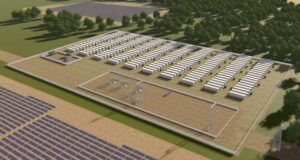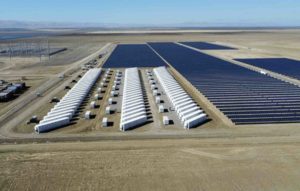New light has been shed on one of the great mysteries of the Australian electricity sector – the actual cost, contract details and merchant revenues of the most exciting new addition to the main grid in the last decade, the Tesla big battery.
Since the world’s biggest lithium-ion battery – officially known as the Hornsdale Power Reserve – was switched on by Tesla founder and CEO Elon Musk late last year, after being delivered in less than 100 days, the battery has stunned observers and the market operator with its speed, accuracy and versality.
Little was known, however, about the financial details of the battery’s construction cost, and contract details with the South Australian government, or its revenue performance to date – although numerous different analyses have been provided by independent observers here and here, and by the market operator itself.
Now, the real numbers – along with some hitherto unreleased power purchase agreements for wind and solar plants – have been revealed in the share registration document lodged by the battery’s owner, the French renewable energy developer Neoen, for its planned initial public offering and stock exchange listing.
The 400-page plus document reveals that the capital cost of the Tesla big battery was €56 million ($A90 million), which is pretty much in line with expectations.
And the document also confirms that the contract it signed with the Jay Weatherill’s South Australia Labor government for the provision of network services amounts to $A4 million a year, for 10 years – although it should be noted this figure is for EBITA (earnings before interest, depreciation and tax), so the actual revenue may be higher.
 The Tesla big battery will actually earn significantly more than that because the 100MW/129MWh battery only has 70MW of capacity (and a small amount of storage) contracted to the South Australia govenment.
The Tesla big battery will actually earn significantly more than that because the 100MW/129MWh battery only has 70MW of capacity (and a small amount of storage) contracted to the South Australia govenment.
Another 30MW, and about 90MWh of storage, is able to play in the merchant market, selling electricity on to the wholesale market by time-shifting the output of wind, or by arbitraging spikes in prices. It also plays in the frequency and ancillary services market (FCAS).
In the first half of 2018, the battery earned €8.1 million ($A13 million) – including €1.4 million from the South Australia contract (around $A2 million), and a further €6.7 million ($A10.8 million) from the sale of stored electricity from the Hornsdale battery.
Most of this market revenue came from the FCAS market, with the battery earning $A7.1 million from the sale of FCAS in the first six months of this year, and $A600,000 in the month of December last year.
All of this suggests that the battery is on track to earn more than $25 million in revenues in its first calendar year – although its profit margins on that project are not made clear.
 Tesla’s role in the FCAS market has helped puncture one of the biggest rorts in the Australian electricity market and smashed the gas cartel’s dominance of the that sector, it also helped Neoen reduce its own FCAS costs incurred by its wind farm operations by more than half, from more than €2 million to less than €1 million.
Tesla’s role in the FCAS market has helped puncture one of the biggest rorts in the Australian electricity market and smashed the gas cartel’s dominance of the that sector, it also helped Neoen reduce its own FCAS costs incurred by its wind farm operations by more than half, from more than €2 million to less than €1 million.
The Australian Energy Market Operator has acknowledged the introduction of the Tesla big battery has significantly reduced the cost of FCAS to market participants, including by $3.5 million in one five hour period when the battery kept prices low during maintenance, when previously the normal gas generators have been able to game the market to their advantage.
AEMO has also praised the battery’s performance in the FCAS market, and on its speed, versatility and accuracy in response to major events – most recently in the major outage that cut power in NSW, Victoria, and Tasmania, and caused problems for two generators in Queensland. South Australia emerged unscathed, partly due to the super-fast response of the battery.
The Tesla battery’s earnings were included in the Australian wind division’s total revenues of €45.2 million in sales in the first half of 2018, up from €18.2 million for the same period last year. This reflected the addition of the battery, and the completion of the second and third stages of the neighbouring 317MW Hornsdale wind farm.
Neoen managed to land a healthy margin of these sales of 86 per cent (€35 million), due to some accounting issues, and because it structures most of its contracts so that its projects are able sell on the wholesale market before the actually PPA begins.
In the case of the Hornsdale wind farm, this has delivered exceptional results, with high electricity prices and high LGC (large scale generation certificate) prices over the past year. The PPA with the ACT only takes effect from next month for the second stage of Hornsdale, and early next year for the third stage.
Those contracts for the three stages of Hornsdale were struck at $A92/MWh, $A77/MWh and $A78/MWh fixed, and were among the few PPAs that have been publicly released.
But the Neoen share offering document sheds more light on the nature of its contracts.
It reveals, for instance, that its deal with the Victoria government to take 90 per cent of the output from the 190MW Bulgana wind farm and the 20MW/34MWh Tesla battery that will accompany it, is between $55/MWh and $65/MWh.
The price for the remaining 10 per cent, which will deliver 97 per cent of the electricity needs of Nectar Farms new $250 million greenhouse facilities, were not revealed.
But other contracts were revealed by the Neoen documents.
This includes an average price of $97/MWh for its portfolio of solar farms, including the 66MW Parkes, 30MW Griffith and the 10.6MW Degrussa solar farm (which is off-grid). The Dubbo solar has a contract only for its LGCs, and this is prices at $40/MWh.
The document also reveals that the PPA struck for the 128MW Nurmurkah solar farm in Victoria is $89/MWh, although the price for the LGCs was struck at just $13/MWh. GFG Alliance is taking the output from Numurak for its Laverton steel works, while the Victoria government is buying the LGCs to offset emissions from its tram network.
The document also reveals that problems with the construction of solar farms – both in terms of cost blowouts and delays – is not confined to the problems experienced by RCR Tomlinson at the two solar farms it is building in north Queensland.
Neoen also reveals it received €14 million ($A22.5 million) in liquidated damages relating to lost revenues from the delays in the commissioning of the Parkes, Dubbo and Griffith solar farms. See our story here.
It also reveals that there is a risk that it and other wind farms face a class action suit should the Australian Energy Regulator impose a fine as a result of the South Australia blackout in September, 2016.













